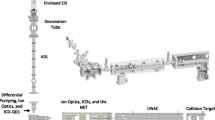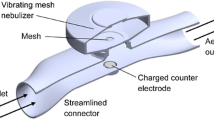Abstract
A novel aerosol charger has been developed, which has high efficiency and high throughput especially for nanometer particles in the size range of 3–50 nm. Unipolar charging with high ion concentration and long charging time is used to obtain the high charging efficiency. High throughput is achieved by reducing particle loss within the charger. This is accomplished by directing ion flow and aerosol flow in the same direction and by the use of sheath air flow. The charger configuration is of a longitudinal design – the direction of aerosol stream and ion stream are flowing parallel along the longitudinal axis of the charger. The charger consists of four sections: the inlet zone, the ion production zone, the unipolar charging zone, and the exit zone. In the inlet and ion production zones, unipolar ions are generated using Po210 radioactive sources with an electric field designed to separate the positive and negative ions, and to focus the selected unipolar ions into the core region of the charger. The ions with the selected polarity is then attracted to the charging zone by an uniform electric field created by a series of ring electrodes applied with a linear ramped voltage. Aerosol entering the charger is sheathed with clean gas flow in order to keep the aerosol in the core region. A novel exit design with a reversed electric field is incorporated in order to minimize the charged particles loss. The performance of the charger is first evaluated using computer simulation and then constructed for experimental validation. Experiment data have demonstrated that the charger achieves 90% and 95% charged-particles penetration efficiency and with 22% and 48% extrinsic charging efficiency at 3 and 5 nm particle sizes, respectively. These performance data represent significant improvement, over a factor of 10, compared with the existing chargers.
Similar content being viewed by others
References
Adachi, M., Y. Kousaka & K. Okuyama (1985). Unipolar and bipolar diffusion charging of ultrafine aerosol particles. J. Aerosol Sci. 16, 109–124.
Adachi, M., D.Y.H. Pui, F.J. Romay & B.Y.H. Liu (1990). Highefficiency unipolar aerosol charger using a radioactive alpha source. In Aerosols: Science, Industry, Health and Environment (Masuda, S. and Takahashi, K. eds.), Pergamon Press, New York, 439–441.
Büscher, P., A. Schmidt-Ott & A. Wiedensohler (1994). Performance of a unipolar 'square wave' diffusion charger with variable nt-product. J. Aerosol Sci. 25, 651–663.
Chen, D.-R., D.Y.H. Pui, D. Hummes, H. Fissan, F.R. Quant & G.J. Sem (1998). Design and evaluation of a nanometer aerosol differential mobility analyzer(Nano-DMA). J. Aerosol Sci. 29, 497–509.
Fuchs, N.A. (1963) On the stationary charge distribution on aerosol particles in bipolar ionic atmosphere, Geofis. Pura Appl. 56, 185–193.
Hussin, A., H.G. Scheibel, K.H. Becker & J. Porstendörfer (1983). Bipolar diffusion charging of aerosol particles-I: Experimental results within the diameter range 4–30 nm, J. Aerosol Sci. 14, 671–678.
Kousaka, Y., M. Adachi, K. Okuyama, N. Kitada & T. Motouchi (1983). Bipolar charging of ultrafine aerosol particles. Aerosol Sci. Technol. 2, 421–427.
Liu, B.Y.H. & D.Y.H. Pui (1974). A submicron aerosol standard and the primary absolute calibration of the condensation nuclei counter. J. Colloid and Interface Sci. 47, 155–171.
Liu, B.Y.H. & D.Y.H. Pui(1977). On Unipolar diffusion charging of aerosols in the continuum regime. J. Colloid and Interface Sci. 58, 1, 142–149.
Mesbath, B. (1994). Le spectromètre de mobilite electriqué circulaire; Performance et applications, Thesis de Doctorrat à l'Université Paris XII, 4 Juil., Creteil, France.
Pourpix, M. & J. Daval (1990). Electrostatic precipitation of aerosol on wafers, a new mobility spectrometer, in 'Aerosols: Science, Industry, Health and Environment' (Pro. on the Third Int. Aerol Conference, 24–27 Sept., 990, Kyoto, Japan), Vol. II, edited by S. Masuda and K. Takahashi, Pergamon Press.
Pourprix, M. (1994). Sélecteur de particules chargées, a haute sensibilité, Brevet francais No. 9406273, 24 Mal.
Pui, D.Y.H. & D.-R. Chen (1997). Nanometer Particles: A new frontier for multi-disciplinary research. J. Aerosol Sci. 4, 539–544.
Pui, D.Y.H., D.-R. Chen & J. Brook (1998). Special Issue: Nanometer Particles. J. Aerosol Sci. 29, 5/6.
Pui, D.Y.H., S. Fruin & P.H. McMurry (1988). Unipolar diffusion charging of ultrafine aerosols. Aerosol Sci. Technol. 8, 173–187.
Reischl, G.P., J.M. Mäkelä, R. Harch & J. Necid (1996). Bipolar charging of Ultrafine particles in the size range below 10 nm, J. Aerosol Sci. 27, 931–949.
Reishl, G., H.G. Scheibel & J. Porstendörfer (1983). Bipolar charging of aerosols: Experimental Results in the size range below 20 nm range diameter. J. Colloid Interface Sci. 91, 272.
Romay, F.J. & D.Y.H. Pui (1992). On the combination coefficient of positive ions with ultrafine neutral particles in the transition and free-molecule regimes. Aerosol Sci. Technol.17, 134–147.
Romay, F.J., D.Y.H. Pui & M. Adachi (1991). Unipolar diffusion charging of aerosol particles at low pressure, Aerosol Sci Technol. 15, 60–68.
Wiedenshler, A., P. Büscher, H.-C. Hansson, B.G. Martinsson, F. Stratmann, G. Ferron & B. Busch (1994). A Novel unipolar charger for ultrafine aerosol particles with minimal particle losses. J. Aerosol Sci. 25, 639–649.
Wiedensohler, A., E. Lükenmeier, M. Feldpausch & C. Helsper (1986) Investigation of the bipolar charge distribution at various gas conditions, J. Aerosol Sci. 17, 413–416.
Winklmayr,W., G.P. Reischl, A.O. Linder & A. Berner (1991). A new electromobility spectrometer for the measurement of aerosol size distributions in the size range from 1 to 1000 nm, J Aerosol Sci. 22, 289–296.
Zhang, S.-H & R.C. Flagan (1996). Resolution of the radial differential mobility analyzer for ultrfine particles, J. Aerosol Sci. 27, 8, 1179–1200.
Zhang, S.-H, Y. Akutsu, L.M. Russell, R.C. Flagan & J.H. Seinfeld (1995). Radial differential mobility analyzer, Aerosol Sci. Technol. 23, 357–372.
Author information
Authors and Affiliations
Rights and permissions
About this article
Cite this article
Chen, DR., Pui, D.Y. A High Efficiency, High Throughput Unipolar Aerosol Charger for Nanoparticles. Journal of Nanoparticle Research 1, 115–126 (1999). https://doi.org/10.1023/A:1010087311616
Issue Date:
DOI: https://doi.org/10.1023/A:1010087311616




